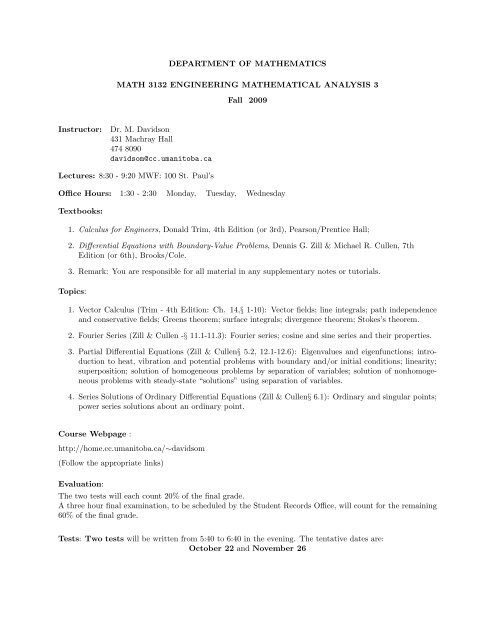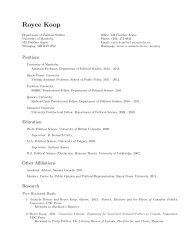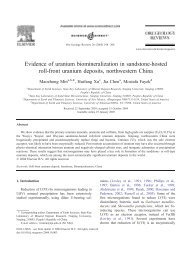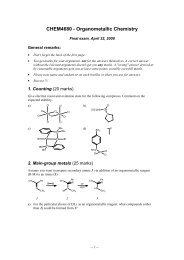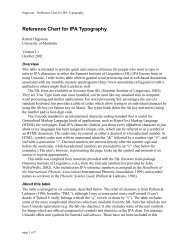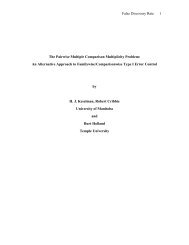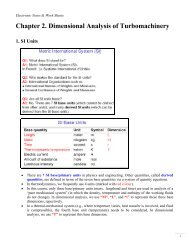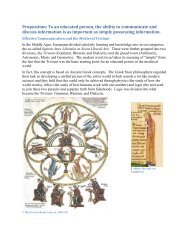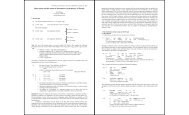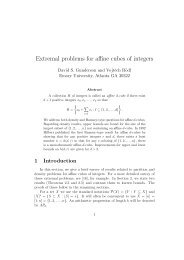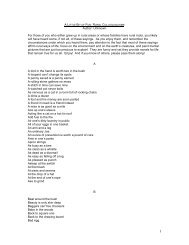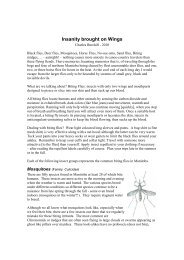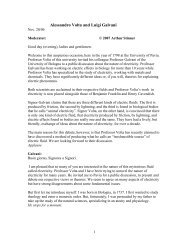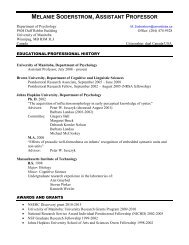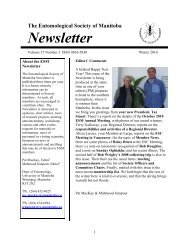department of mathematics math 3132 engineering mathematical
department of mathematics math 3132 engineering mathematical
department of mathematics math 3132 engineering mathematical
You also want an ePaper? Increase the reach of your titles
YUMPU automatically turns print PDFs into web optimized ePapers that Google loves.
DEPARTMENT OF MATHEMATICS<br />
MATH <strong>3132</strong> ENGINEERING MATHEMATICAL ANALYSIS 3<br />
Instructor: Dr. M. Davidson<br />
431 Machray Hall<br />
474 8090<br />
davidsom@cc.umanitoba.ca<br />
Lectures: 8:30 - 9:20 MWF: 100 St. Paul’s<br />
Fall 2009<br />
Office Hours: 1:30 - 2:30 Monday, Tuesday, Wednesday<br />
Textbooks:<br />
1. Calculus for Engineers, Donald Trim, 4th Edition (or 3rd), Pearson/Prentice Hall;<br />
2. Differential Equations with Boundary-Value Problems, Dennis G. Zill & Michael R. Cullen, 7th<br />
Edition (or 6th), Brooks/Cole.<br />
3. Remark: You are responsible for all material in any supplementary notes or tutorials.<br />
Topics:<br />
1. Vector Calculus (Trim - 4th Edition: Ch. 14,§ 1-10): Vector fields; line integrals; path independence<br />
and conservative fields; Greens theorem; surface integrals; divergence theorem; Stokes’s theorem.<br />
2. Fourier Series (Zill & Cullen -§ 11.1-11.3): Fourier series; cosine and sine series and their properties.<br />
3. Partial Differential Equations (Zill & Cullen§ 5.2, 12.1-12.6): Eigenvalues and eigenfunctions; introduction<br />
to heat, vibration and potential problems with boundary and/or initial conditions; linearity;<br />
superposition; solution <strong>of</strong> homogeneous problems by separation <strong>of</strong> variables; solution <strong>of</strong> nonhomogeneous<br />
problems with steady-state “solutions” using separation <strong>of</strong> variables.<br />
4. Series Solutions <strong>of</strong> Ordinary Differential Equations (Zill & Cullen§ 6.1): Ordinary and singular points;<br />
power series solutions about an ordinary point.<br />
Course Webpage :<br />
http://home.cc.umanitoba.ca/∼davidsom<br />
(Follow the appropriate links)<br />
Evaluation:<br />
The two tests will each count 20% <strong>of</strong> the final grade.<br />
A three hour final examination, to be scheduled by the Student Records Office, will count for the remaining<br />
60% <strong>of</strong> the final grade.<br />
Tests: Two tests will be written from 5:40 to 6:40 in the evening. The tentative dates are:<br />
October 22 and November 26
Notes:<br />
1. Voluntary Withdrawal Deadline: Wednesday, November 18, 2009.<br />
2. For the tests and the final exam, you may not bring any notes, text(s), calculator or other aid or cell<br />
phones. However, you will be provided with some relevant formulae.<br />
3. If you miss a test then you will automatically be given a “zero” mark unless reasons are provided<br />
together with evidence (e.g. letter from a medical doctor), in which case the final mark will be<br />
adjusted. No make-up test will be given.<br />
4. Read the Academic Dishonesty Policy (below).<br />
Academic Dishonest Policy:<br />
The Department <strong>of</strong> Mathematics, the Faculty <strong>of</strong> Science and the University <strong>of</strong> Manitoba regard acts <strong>of</strong> academic<br />
dishonesty in quizzes, tests, examinations or assignments as serious <strong>of</strong>fenses and may assess a variety<br />
<strong>of</strong> penalties depending on the nature <strong>of</strong> the <strong>of</strong>fense.<br />
Acts <strong>of</strong> academic dishonesty include bringing unauthorized materials into a test or exam, copying from another<br />
student, plagiarism and examination personation. Students are advised to read section 7 (Academic<br />
Integrity) and section 4.2.8 (Examinations: Personations) in the ”General Academic Regulations and Requirements”<br />
<strong>of</strong> the current Undergraduate Calendar. Note, in particular that cell phones and pagers<br />
are explicitly listed as unauthorized materials, and hence may not be present during tests or<br />
examinations.<br />
Penalties for violation include being assigned a grade <strong>of</strong> zero on a test or assignment, being assigned a grade <strong>of</strong><br />
”F” in a course, compulsory withdrawal from a course or program, suspension from a course/program/faculty<br />
or even expulsion from the University. For specific details about the nature <strong>of</strong> penalties that may be assessed<br />
upon conviction <strong>of</strong> an act <strong>of</strong> academic dishonesty, students are referred to University Policy 1202 (Student<br />
Discipline Bylaw) and to the Department <strong>of</strong> Mathematics policy concerning minimum penalties for acts <strong>of</strong><br />
academic dishonesty.<br />
The Student Discipline Bylaw is printed in its entirety in the Student Guide, and is also available on-line or<br />
through the Office <strong>of</strong> the University Secretary. Minimum penalties assessed by the Department <strong>of</strong> Mathematics<br />
for acts <strong>of</strong> academic dishonesty are available on the Department <strong>of</strong> Mathematics web-page.<br />
All Faculty members (and their teaching assistants) have been instructed to be vigilant and report incidents<br />
<strong>of</strong> academic dishonesty to the Head <strong>of</strong> the Department.
Recommended Homework Problems:<br />
Trim: Note: the questions below refer to the 4th Edition.<br />
§ 14.1: even nos. 22–58, 59, 60.<br />
§ 14.2: even nos. 2–16, 17 (see § 7.9), 18.<br />
§ 14.3: even nos. 2–20; 11 [ans: 3235/12], 35 [ans: (a) 0, (b) 2πr 2 ].<br />
§ 14.4: even nos. 2–10, 11, even nos. 14–20, 24; also ♯ 20 (§ 14.3), using methods <strong>of</strong> § 14.4.<br />
§ 14.5: even nos. 2–10.<br />
§ 14.6: even nos. 2–12, 13, 14, even nos. 18–28, 36, 37, 38.<br />
§ 14.7: even nos. 2–12, 16, even nos. 18–22: use “projection”; do not use area element.<br />
§ 14.8: even nos. 2–18, 24.<br />
§ 14.9: even nos. 2–16, 17, 22, 24, 25, 26, 27.<br />
§ 14.10:♯ 1 [ans: 4π ], even nos. 2–12, 15, 16.<br />
⎡<br />
�<br />
Review: even nos. 2–30, 31(a) ⎣4<br />
√ 2 √ 2−2<br />
0<br />
� � 1−x 2 − x4<br />
4<br />
0<br />
⎤<br />
x 2 y 2 � 1 − x2 − y2 dxdy⎦<br />
Zill & Cullen: NOTE: Copies <strong>of</strong> the Complete Solutions Manual for Zill & Cullen are in the Engineering<br />
Library.<br />
§ 11.1: ♯ 1, 2, 3, 7 (ignore norm).<br />
§ 11.2: ♯ 1–9, 13, 14.<br />
§ 11.3: ♯ 1–19, 25–29, 35–38.<br />
Chapter 11 Review: ♯ 1–8, 11, 13–15.<br />
§ 5.2: ♯ 9, 10–13, 16.<br />
§ 12.1: odd nos. ♯ 17–25.<br />
§ 12.2: ♯ 1–10.<br />
§ 12.3: ♯ 1–6.<br />
§ 12.4: ♯ 1, 2, 4–11.<br />
§ 12.5: ♯ 4, 5, 9. Note: In ♯ 4, take a = b = 1; i.e., 0 < x < 1, 0 < y < 1.<br />
Answers will be provided (see course website).<br />
§ 6.1: ♯ 15, 16, 19, 23, 27, 31.<br />
NOTE: It is important to do all tutorial questions.


